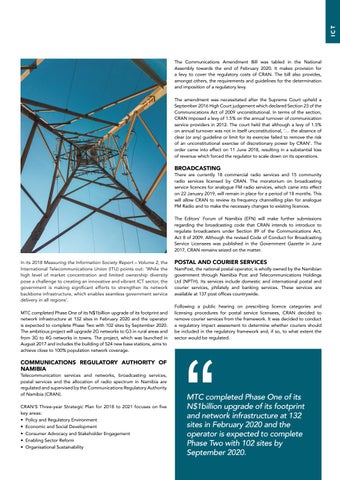ICT The Communications Amendment Bill was tabled in the National Assembly towards the end of February 2020. It makes provision for a levy to cover the regulatory costs of CRAN. The bill also provides, amongst others, the requirements and guidelines for the determination and imposition of a regulatory levy. The amendment was necessitated after the Supreme Court upheld a September 2016 High Court judgement which declared Section 23 of the Communications Act of 2009 unconstitutional. In terms of the section, CRAN imposed a levy of 1.5% on the annual turnover of communication service providers in 2012. The court held that although a levy of 1.5% on annual turnover was not in itself unconstitutional, ‘… the absence of clear (or any) guideline or limit for its exercise failed to remove the risk of an unconstitutional exercise of discretionary power by CRAN’. The order came into effect on 11 June 2018, resulting in a substantial loss of revenue which forced the regulator to scale down on its operations.
BROADCASTING
There are currently 18 commercial radio services and 15 community radio services licensed by CRAN. The moratorium on broadcasting service licences for analogue FM radio services, which came into effect on 22 January 2019, will remain in place for a period of 18 months. This will allow CRAN to review its frequency channelling plan for analogue FM Radio and to make the necessary changes to existing licences. The Editors’ Forum of Namibia (EFN) will make further submissions regarding the broadcasting code that CRAN intends to introduce to regulate broadcasters under Section 89 of the Communications Act, Act 8 of 2009. Although the revised Code of Conduct for Broadcasting Service Licensees was published in the Government Gazette in June 2017, CRAN remains seized on the matter. In its 2018 Measuring the Information Society Report – Volume 2, the International Telecommunications Union (ITU) points out: ‘While the high level of market concentration and limited ownership diversity pose a challenge to creating an innovative and vibrant ICT sector, the government is making significant efforts to strengthen its network backbone infrastructure, which enables seamless government service delivery in all regions’. MTC completed Phase One of its N$1billion upgrade of its footprint and network infrastructure at 132 sites in February 2020 and the operator is expected to complete Phase Two with 102 sites by September 2020. The ambitious project will upgrade 2G networks to G3 in rural areas and from 3G to 4G networks in towns. The project, which was launched in August 2017 and includes the building of 524 new base stations, aims to achieve close to 100% population network coverage.
POSTAL AND COURIER SERVICES
NamPost, the national postal operator, is wholly owned by the Namibian government through Namibia Post and Telecommunications Holdings Ltd (NPTH). Its services include domestic and international postal and courier services, philately and banking services. These services are available at 137 post offices countrywide. Following a public hearing on prescribing licence categories and licensing procedures for postal service licensees, CRAN decided to remove courier services from the framework. It was decided to conduct a regulatory impact assessment to determine whether couriers should be included in the regulatory framework and, if so, to what extent the sector would be regulated.
COMMUNICATIONS REGULATORY AUTHORITY OF NAMIBIA
Telecommunication services and networks, broadcasting services, postal services and the allocation of radio spectrum in Namibia are regulated and supervised by the Communications Regulatory Authority of Namibia (CRAN). CRAN’S Three-year Strategic Plan for 2018 to 2021 focuses on five key areas: • Policy and Regulatory Environment • Economic and Social Development • Consumer Advocacy and Stakeholder Engagement • Enabling Sector Reform • Organisational Sustainability
MTC completed Phase One of its N$1billion upgrade of its footprint and network infrastructure at 132 sites in February 2020 and the operator is expected to complete Phase Two with 102 sites by September 2020. w w w. n a m i b i a t r a d e d i r e c t o r y. c o m
131
